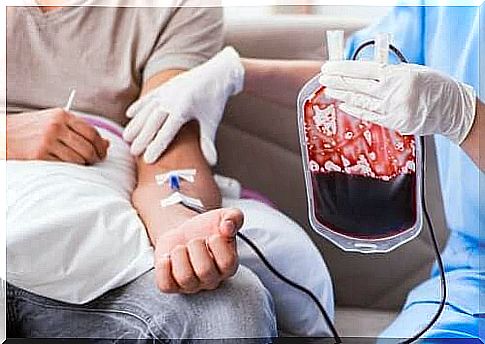Blood Transfusions: Purpose And Procedure

Blood transfusions are one of the cornerstones of modern medicine. This procedure saves many lives by replacing the blood lost by the patient due to an injury.
The first blood transfusion was performed in the 17th century. But scientists were only able to identify the different blood groups in the 20th century. Until then, blood transfusions could endanger the patient’s life.
Blood groups are a classification of blood according to the characteristics of their red blood cells and serum. If a person receives blood that has a different group than his own, incompatibility reactions occur and the risk of death increases.
This idea was essential in the development of blood transfusions and, thanks to it, this procedure became very safe and effective. In today’s article, we present everything you need to know about this topic.
How are blood transfusions performed?
Blood transfusions are a routine procedure in contemporary medicine. The transfused patient receives blood or one of its derivatives from another person. The blood contains the following elements:
- Red blood cells, which are responsible for transporting oxygen and which help to dispose of waste
- White blood cells, which help the body fight infections
- Platelets, which contribute to blood clotting
- Plasma, which is the solid component of the blood
In order for transfusions to be performed, someone must donate their blood. Donors are, of course, volunteers who do not receive remuneration for this gesture.
What does blood donation entail?

Blood donation is a very simple procedure that can save a person’s life. To be a blood donor, you must have an adequate state of health, weigh at least 50 kg, not be anemic and not suffer from any other health problem.
Blood donation is done in specialized centers or in health campaigns that usually take place in public places such as schools, universities or town halls.
Once there, you will sit on a chair, with your arm outstretched on an armrest. A lab technician will take your blood pressure and make sure you are in optimal health to donate blood. Then the specialist will tie a garou around your arm.
The laboratory technician will easily find a suitable vein and insert a needle into it. The needle must be sterile and the skin will be cleaned before insertion. After the needle has been inserted, the blood will fill a bag of about 500 ml.
The procedure is much simpler than it seems and, in addition, it is painless. It will take about 10 minutes. Then, the lab technician will give you a small snack so that you can recover. This procedure rarely leads to complications.
According to some studies, approximately 92 million units of blood are donated each year. But there is still a deficit of 22 million units globally. So each of us should try to become a donor.
What is the purpose of blood transfusions?
Blood transfusions are used to treat patients who have deficiencies in any of the blood components. This category includes, for example, people who do not produce blood cells.
Doctors use transfusions to treat hemophilia, to ensure that patients’ bodies can coagulate properly. Transfusions are also recommended in the following situations:
- After bleeding, to restore blood volume
- After major surgery in which a lot of blood can be lost, such as organ transplants or repairing injuries
- In case of chronic anemia
- To help patients who are undergoing chemotherapy
What are the risks of this procedure?
In general, blood transfusions are not dangerous. But problems can occur even in cases with a low risk of complications. The most common of these is small allergic reactions that cause hives and fever.
Although laboratory technicians test donated blood to rule out communicable infections such as HIV or hepatitis, blood transfusions can lead to infections.
Unfortunately, some transfusions can cause immune reactions. The immune system can attack foreign red blood cells obtained through transfusions.
Conclusion
Blood transfusion is a procedure that can save a patient’s life. For this reason, it is important for all healthy people to know that they too can donate blood. After all, it is not known when we ourselves will need the blood of a donor.









